KPM, MS Boissevain, Tegelberg & Ruys -
19/37/38 to 1942
Please Note: Firefox, iPhones, iPads & some other Search Engines may not be suitable
Use Internet
Explorer & Old
Google for this Web Page to load perfectly!
Please
Note: All ssmaritime and my other related
ssmaritime sites are 100% non-commercial and privately owned sites. Be assured
that I am NOT associated with any cruise or shipping companies or travel/cruise
agencies or any other organisations! The author has been in the passenger
shipping industry since May 1960 and is now semi-retired, but continues to
write article on classic liners and cruise ships in order to better to inform
cruise and ship enthusiasts for their pleasure!
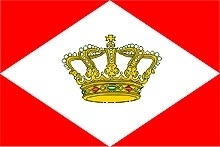
Part One
The Three Ships from 1937 to 1942
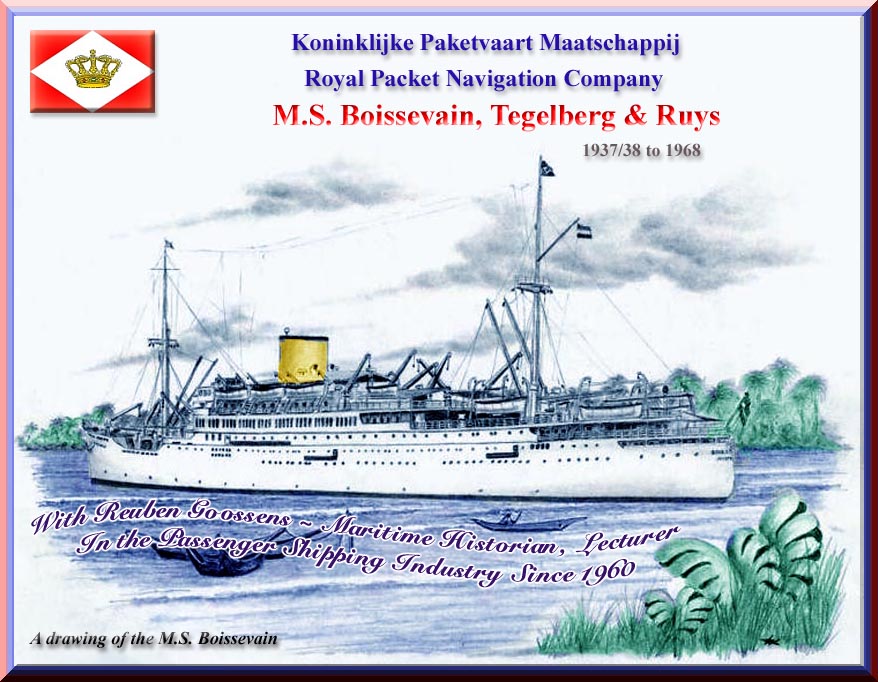
Sadly
the artist is unknown - See the photo/images notes at the bottom of the page
Please Note: Postcards, photographs & other images are from the Author’s private collection
Interior & deck photographs ‘maritiemdigitaal.nl,’ unless otherwise stated.
Introduction:
This feature contains the most comprehensive
information and details regarding these three amazing and the largest of the Koninklijke
Paketvaart-Maatschappij (KPM) passenger-cargo
(combination) liners ever built. These three fine ships were also sadly their
very last major passenger carrying liners, and with them eventually came an end
of a great Passenger operation between Asia, Africa, and
These three Dutch liners were all launched in
1937, yet strangely each ship was built by a different builder, as well as one
outside of the
Koninklijke Paketvaart-Maatschappij -
“KPM” or the “Royal Packet Navigation Company’s”
three combination liners were built not long before World War Two, those being
the MS Boissevain, Tegelberg and Ruys. They all operated extended voyages from
Hong Kong,
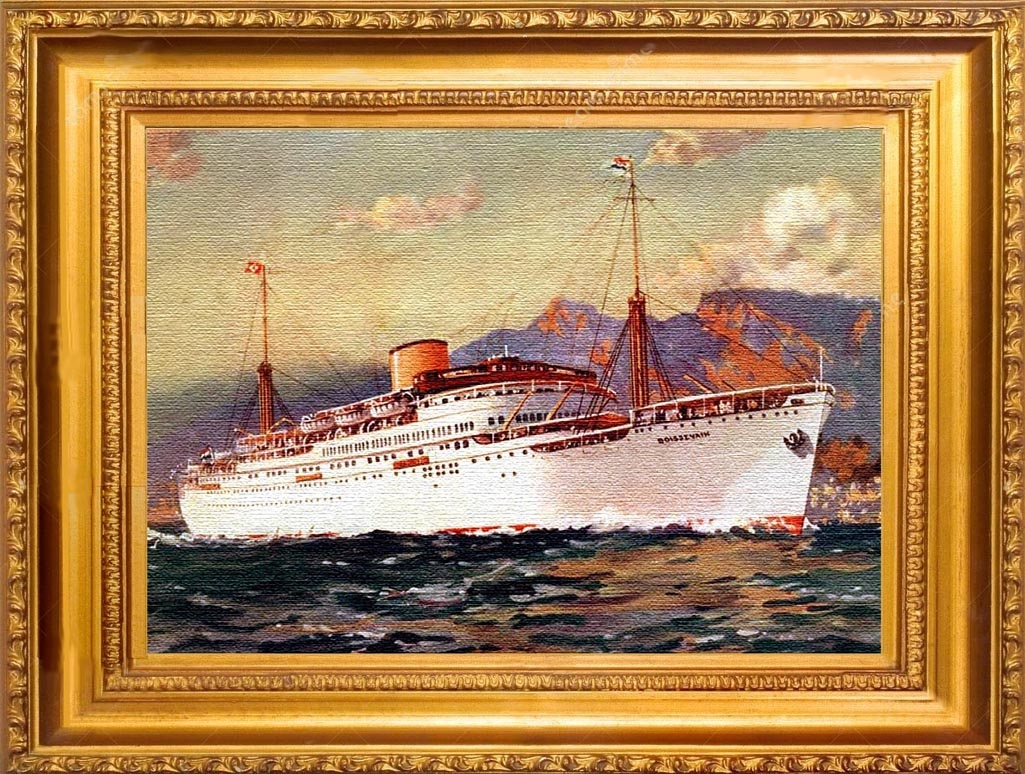
Here we see a KPM preview painting of the MS Boissevain prior to her launching
The three ships were originally built with luxurious and extremely spacious accommodations for just 82 passengers in First Class, 72 passengers in Second Class, and 500 Third Class passengers.
First Class passengers enjoyed artistically
designed public rooms, two deluxe suites even had glass enclosed private
verandas, there were spacious promenade and sports decks and a Lido Cafe
opening onto a tiled outdoor Pool. These hardworking ocean liners accommodated
all manner of travellers from the very wealthy to International and Asian
tourists as well as migrants immigrating to a new land. In their thirty years
of operation, these ships certainly made a name for themselves as they became
greatly loved for being some of the best run combination liners in the world,
with exemplary service and the ultimate in finer cuisine. As well as the
excellent interiors of these amazing liners!
The Four Smaller Sisters:
In addition there were also two remarkable
liners in operation at that time, being the 1928 built 10.906 GRT (Gross
Registered Tons) SS Nieuw Holland and her identical sister the SS Nieuw
Zeeland, which operated from Asia to
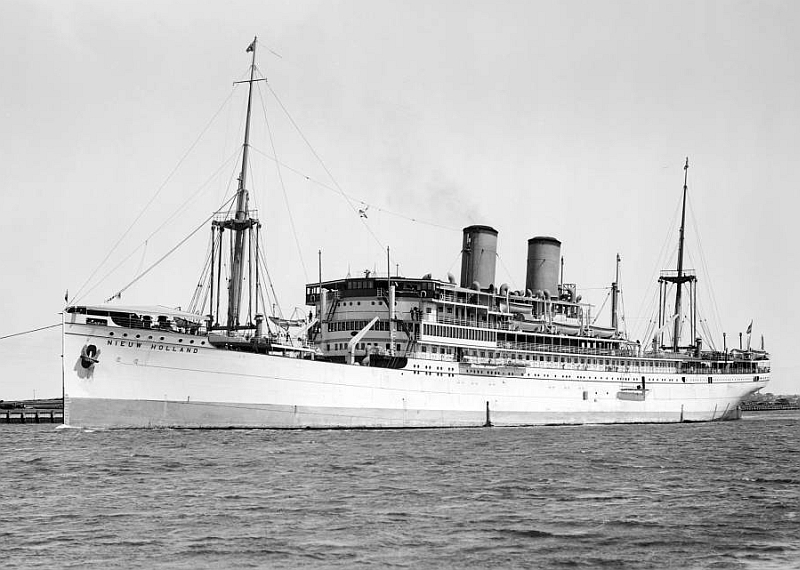
The Grand
Old Dame, SS Nieuw Holland is seen arriving in
The company also operated the smaller 1950
built - 9,859 GRT - MS Tjiluwah and Tjiwangi that operated a more cruise-style,
but a regular line service between
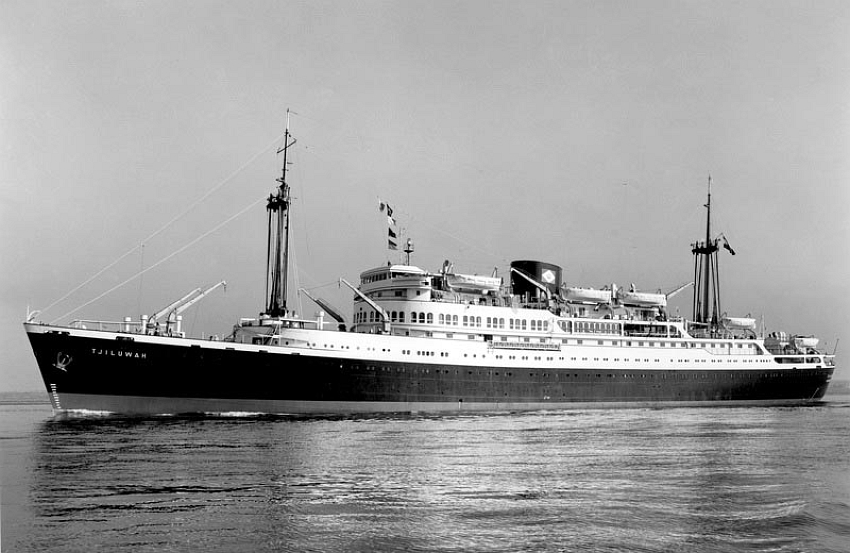
The
elegant yacht-like liner MS Tjiluwah is seen during her deep-sea trials in 1951
The now all white ships the MS Tjiluwah was
sold to a Singaporean Company in 1971, renamed Kota Singapora,
and was finally broken up in 1980, whilst the Tjiluwah was sold in 1972 to
Pacific International Lines, and was renamed Kota Bali and she was broken up in
1984.
Read my multi pages on the SS Nieuw Holland
and Nieuw Zeeland, as well as the MS
Tjiwangi & Tjiluwah. These pages contain full details of these
four fine ships, and you can reach them via the link located at the bottom of
this page.
(1) M.S. Boissevain:
The first of the trio was the MS Boissevain
and she was built in
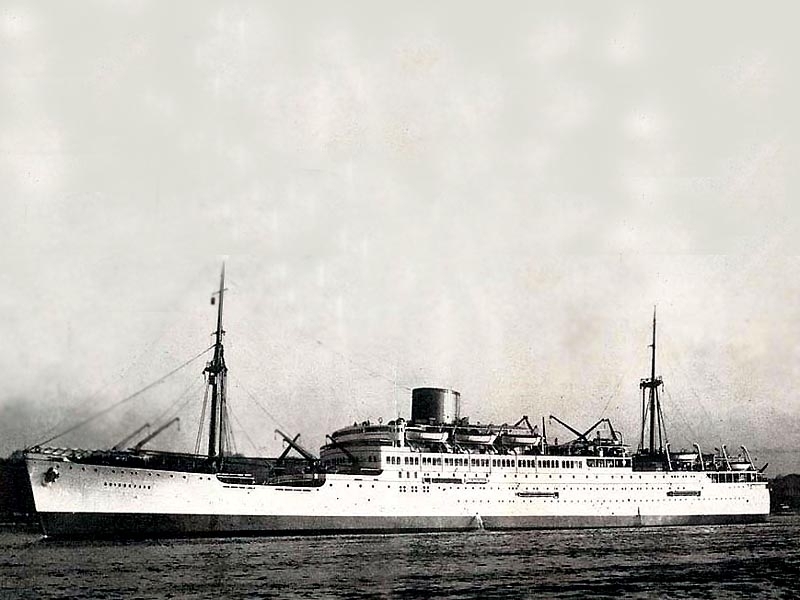
MS Boissevain the first of the three KPM combination liners
On June 3, 1937 with the ship having had her hull and a partial superstructure completed, was officially named and launched by Miss. E.D. Boissevain the great grand daughter of Mr. J. Boissevain who passed away in 1904. Once the ship was afloat she was towed to her Blohm & Voss Fit-Out berth, where she would be completed to become a fine combination liner.
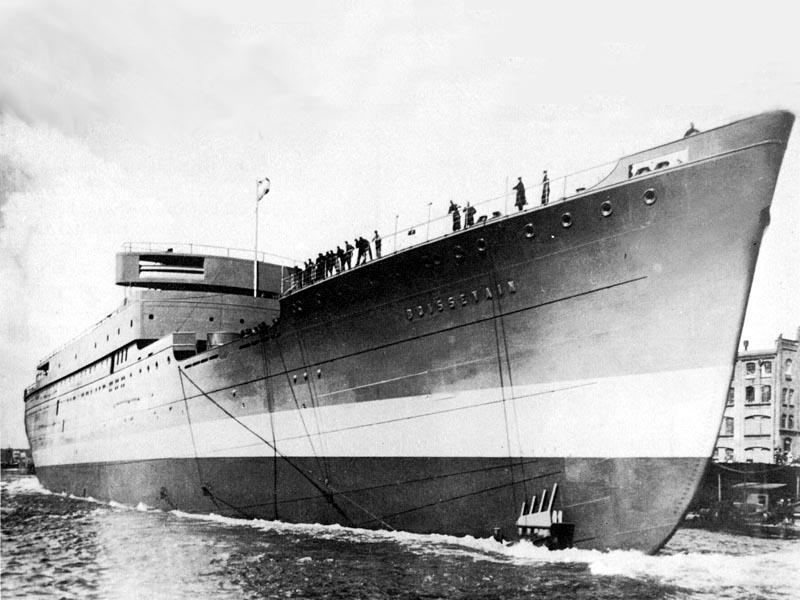
The MS Boissevain having come down the Blohm & Voss slipway has just entered the water for the very first time
At the yard she was fitted out, had her funnel
placed atop and masts added and when she was completed in October she headed
out to sea for her speed trials, which proved to be very successful having
reached an excellent 18.1 knots when pushed to her top speed.
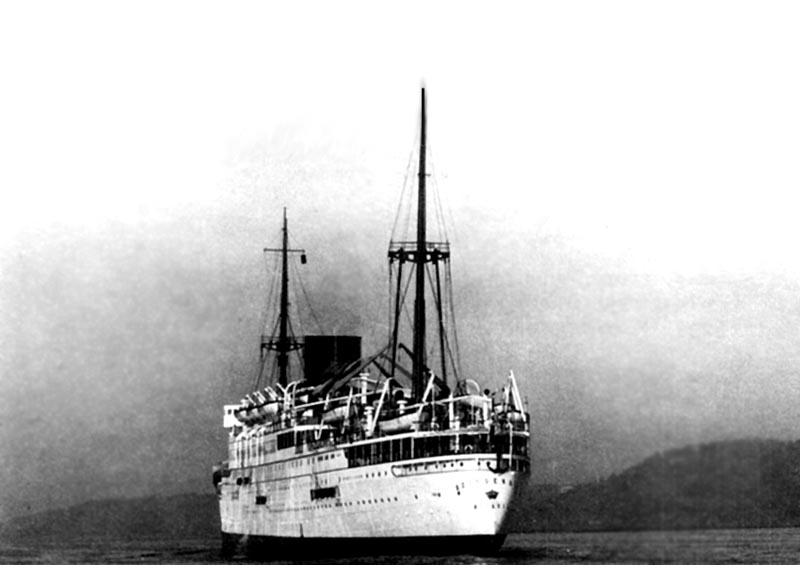
The Boissevain is seen here during her Deep Sea Speed Trials in October 1937
The Boissevain was delivered to her owners in
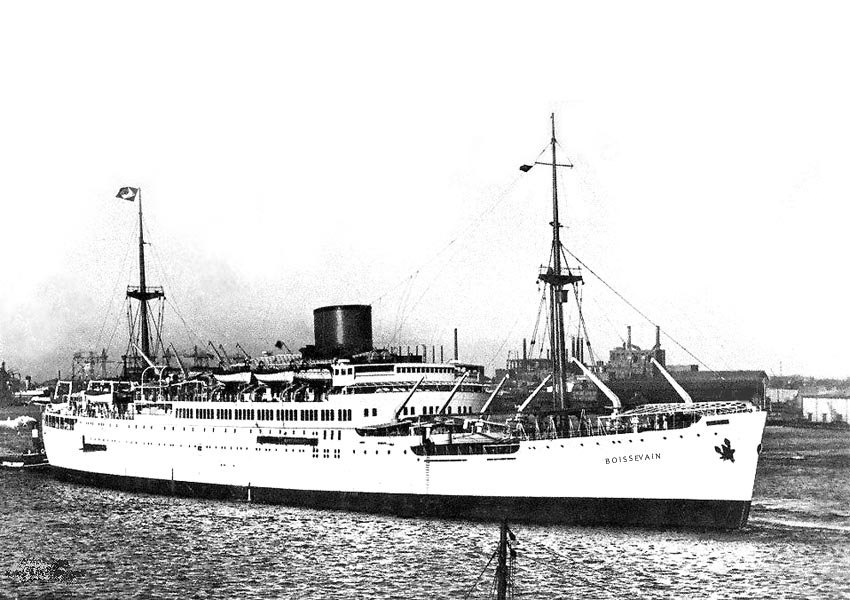
The just
completed MS Boissevain seen departing on her inaugural voyage to
Prior to the MS Boissevain even being
completed, KPM released an advanced 1938 sailing schedule with an artist
impression of The Boissevain on the cover.
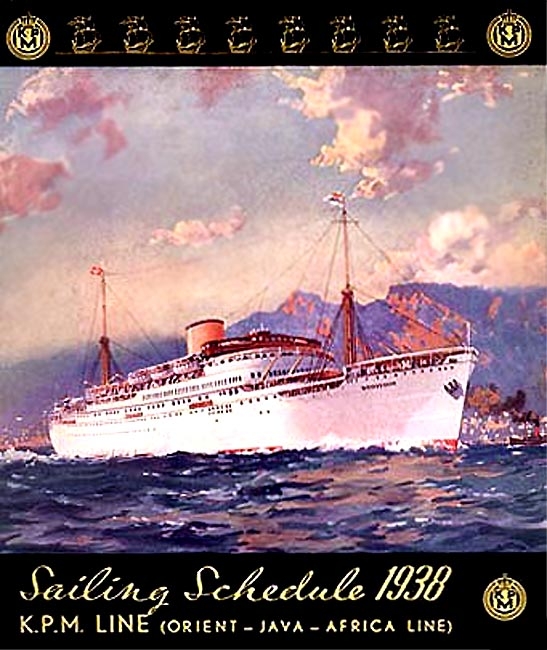
This schedule contained sailings for all three ships; the MS Boissevain, Tegelberg, and the Ruys
Provided by www.timetableimages.com/maritime/images/list.htm (C) Björn Larson
January to September 1938 Schedule: Hong Kong, Manila, Saigon, Bangkok, Singapore, Batavia, Rodriguez,
Mauritius, Réunion, Tamatave, Lourenço Marques, Durban, East London, Port
Elizabeth, Mossel Bay, Cape Town. Other ports visited were
She was the second of the three ships to be
built and she and her Sulzer Diesel Engines were constructed by the
Netherland’s Shipbuilding Company in
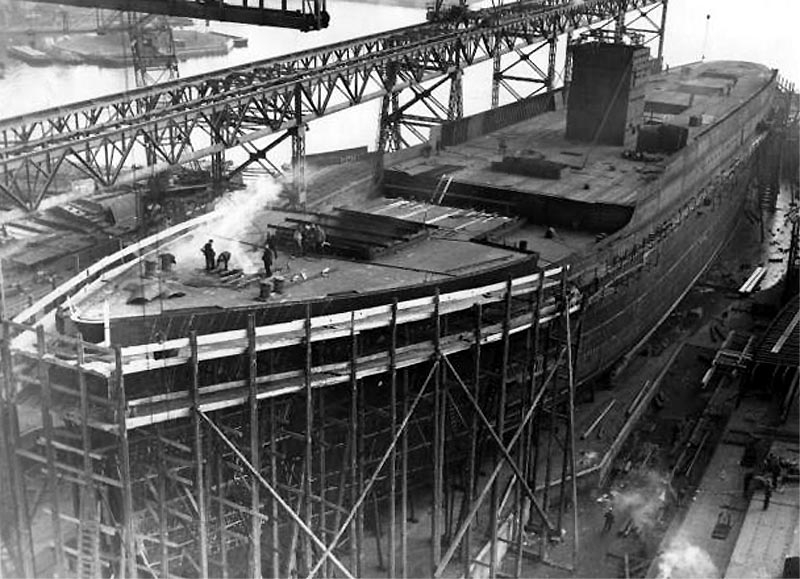
The
Tegelberg is seen still under construction at the Netherland’s
Shipbuilding Co in
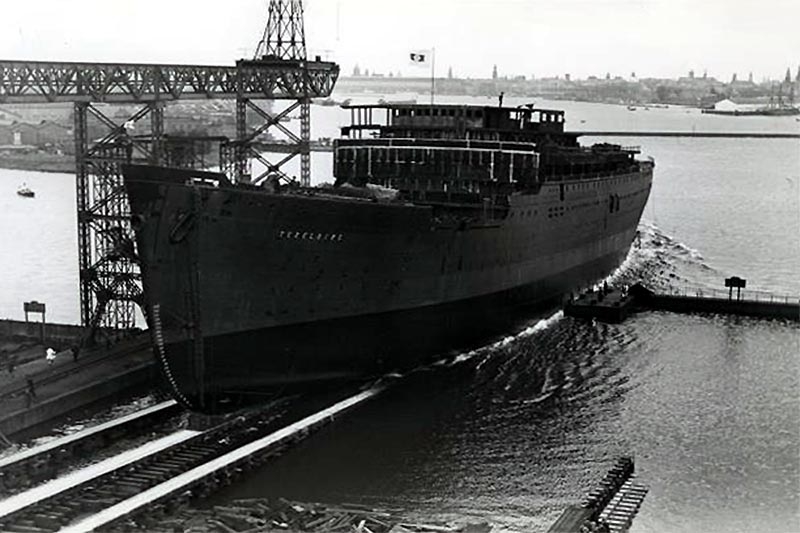
The
Tegelberg slides down the slipway into the water on July 10, 1937
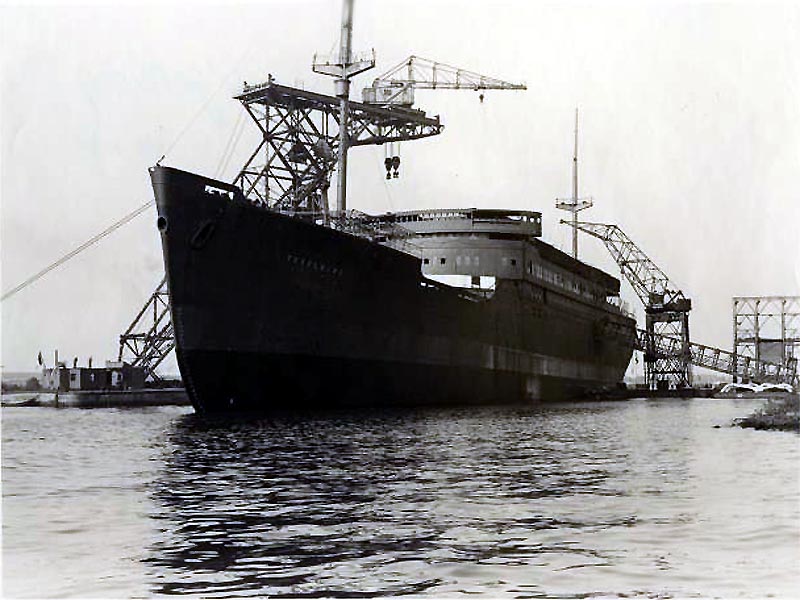
Here we see the Tegelberg at the Netherland’s Shipbuilding Co fit-out yards being completed
The MS Tegelberg was completed on March 8,
1938 having had a successful sea trial and was soon delivered to KPM. Later
that month she departed on her maiden voyage on the same schedule as the
Boissevain as shown above.
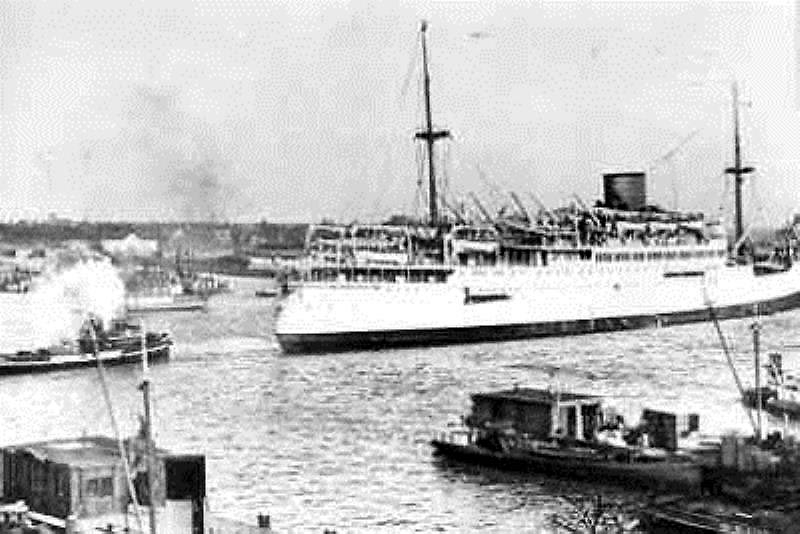
Here we
see a very rare photo of the Tegelberg departing
(3) M.S. Ruys:
Now the last of the trio to be built was
constructed by De Schelde Shipyards in
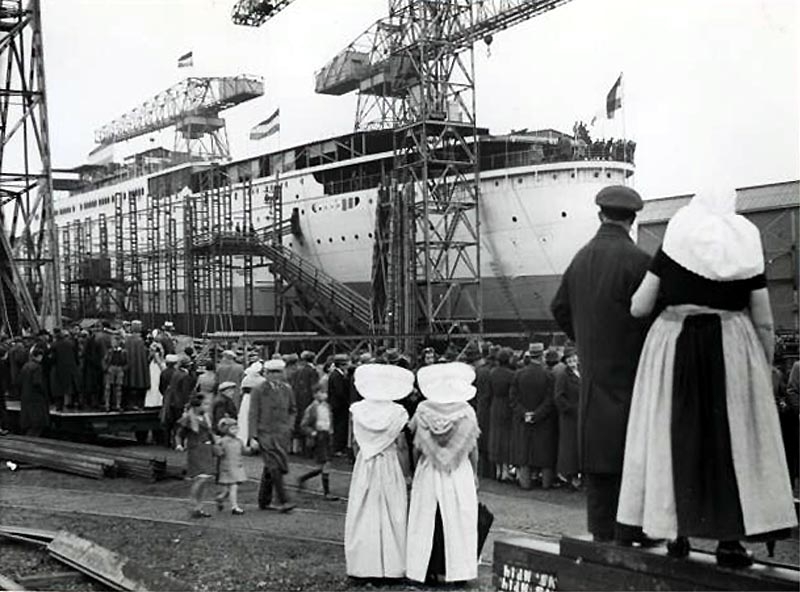
A genuine
Dutch audience waiting for the MS Ruys to be launched on September 21, 1937
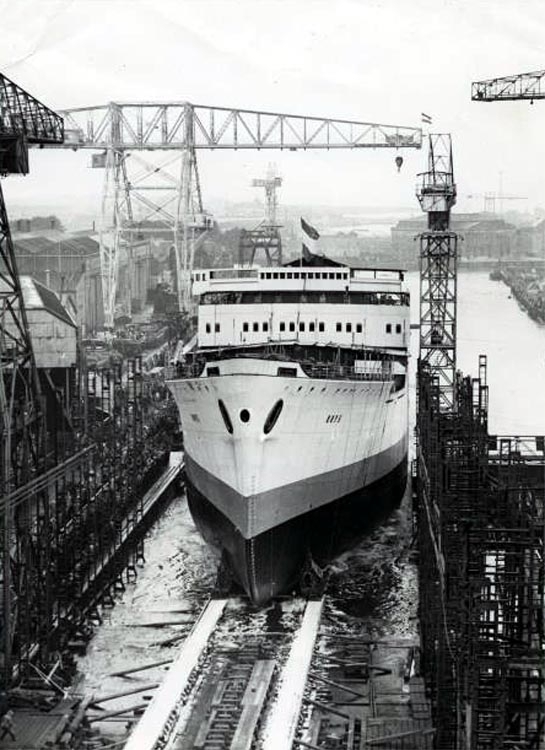
Above & below: Here we see the MS Ruys sliding down the De Schelde slipway during her launching on September 21, 1937
As well
as two photographs below of her in the water for the first time, waiting for
tugs to be towed to her fit-our berth
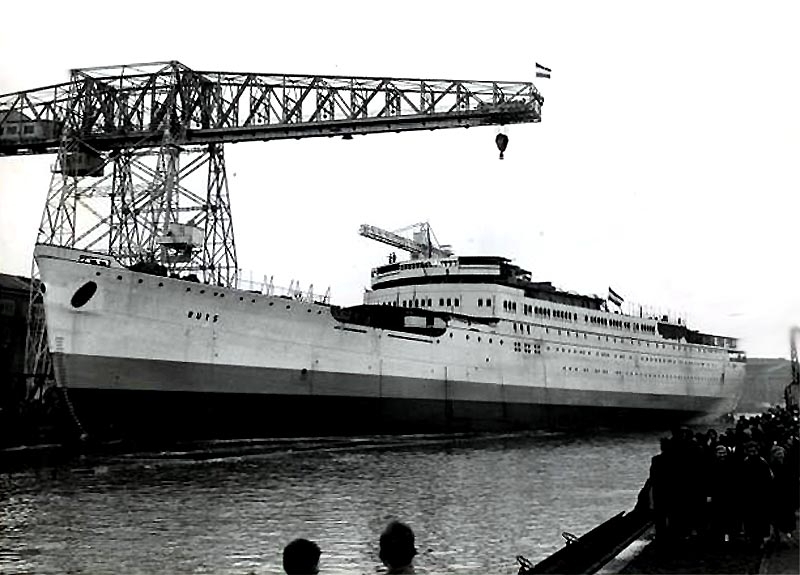
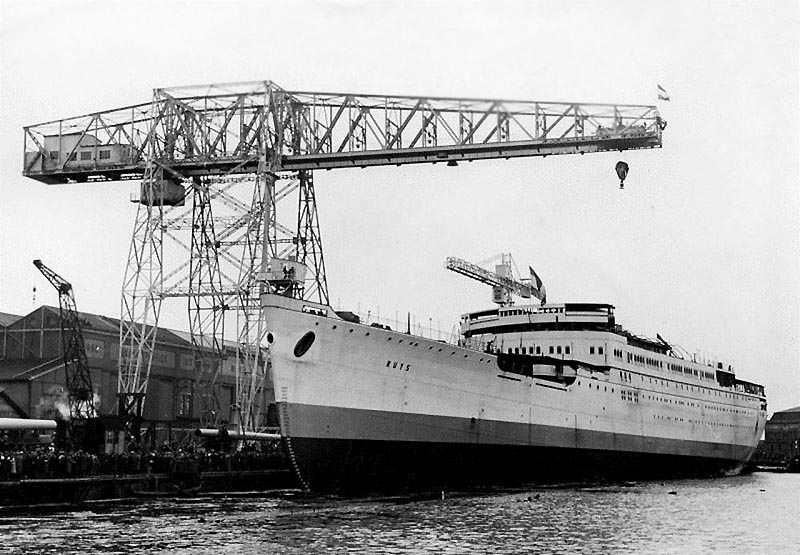
Construction on the MS Ruys was completed in March 1938 and she was taken out on the North Sea to operate her Deep Sea Speed Trials on March 21, 1938 after which she was delivered on April 7 to her owners and she headed to Japan, were she commenced her regular schedule around Asia, the Indian Ocean and Africa and return.
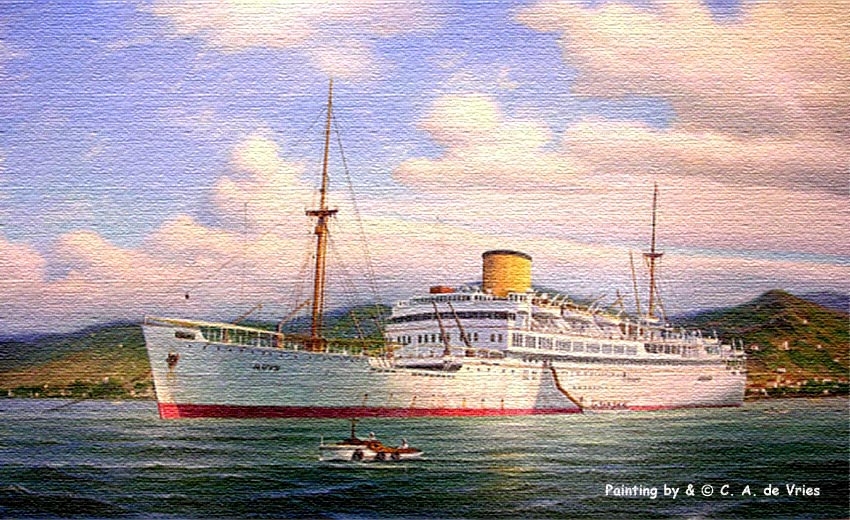
An excellent painting of the all-new KPM MS Ruys seen as new
Painting
by Dutch Maritime Artist & © Mr. C. A. de Vries
When the MS Tegelberg and Ruys were completed
they joined the MS Boissevain on her schedule being valid until to September
1938, ports being as follows: Hong Kong,
Interiors & Facilities:
With all three ships now operating on the same service, they soon became very popular, due to their stunning interiors, the ultimate in service and the cuisine was rated as some of the best at sea! Below, I will go through the ships Decks. For the moment I will deal just with First Class, but will cover Second (Intermediate) Class later, after the ships were transferred to Royal Interocean Lines and refitted in 1962.
Bridge Deck:
This deck had a small amount of deck space, but its main passenger feature here was the well-equipped Gym for those early days!
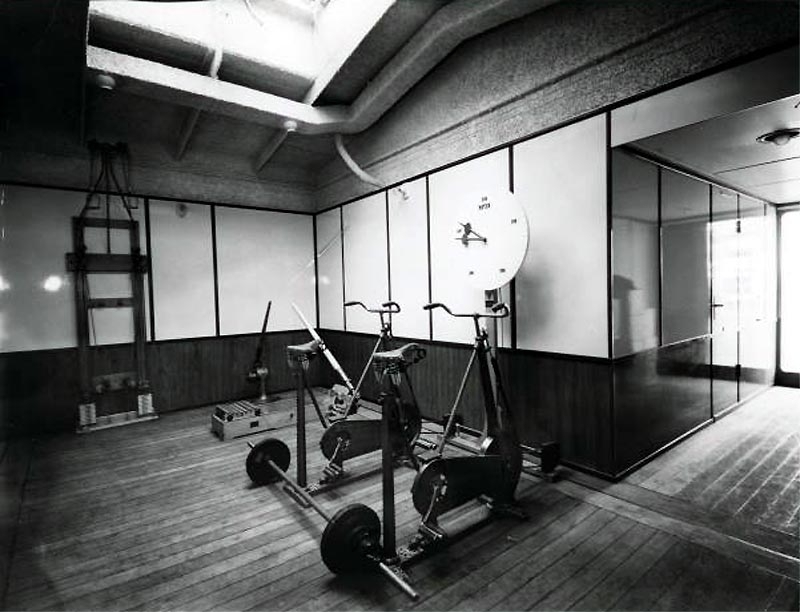
The Gym
Boat Deck:
Boat Deck offered a full-uncluttered walk-around deck, and being the First Class Sports deck. Aft of the superstructure there was a nursery and an exterior playpen and the “Wireless Station” with a small waiting room located starboard side, or the right hand side looking forward. This deck also offered a spacious deck, perfect for a variety of sport activities!
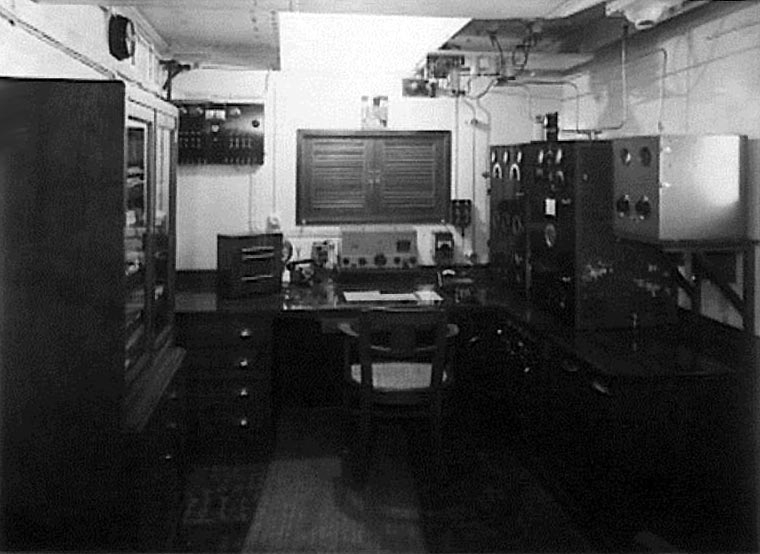
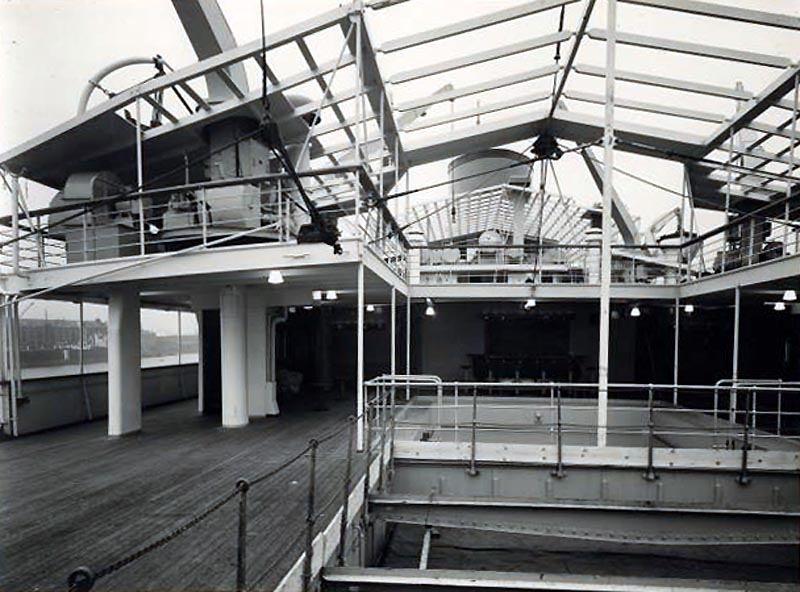
Boat Deck above is seen from Promenade Deck aft looking forward
Promenade Deck:
Commencing from forward, Public Venues commences with the spacious Social Hall that has windows forward and on the two sides looking out to the glazed in Promenade. Centred in the ceiling is a spectacular circular light fitting, with additional lighting located above the curtain pelmets above the windows. The venue offered comfortable heavily upholstered lounge chairs with a patterned brocade, as well as a number of sofas. Aft of the venue was a fine stairwell going down to A Deck.
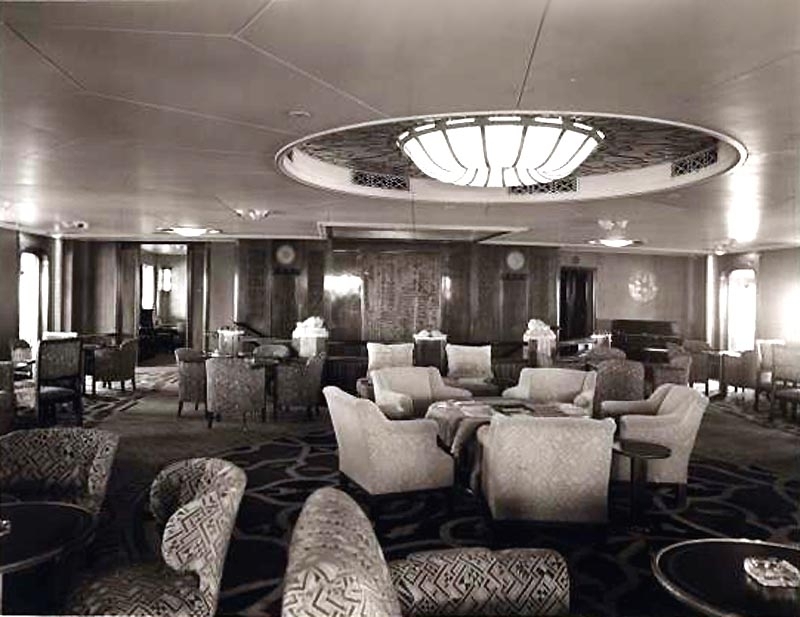
The Social
Hall looking aft, with the Library and Reading Room seen on the left (starboard
side)
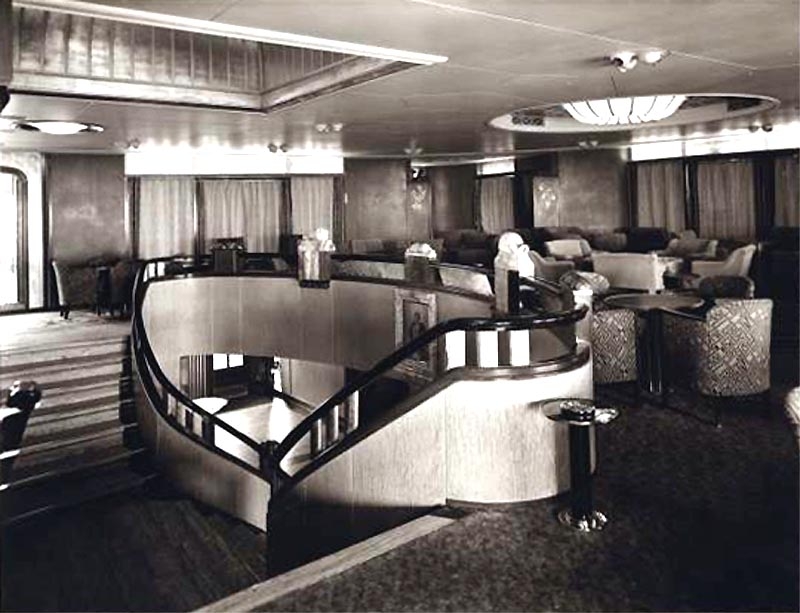
The Social
Hall looking forward to port and the aft stairwell
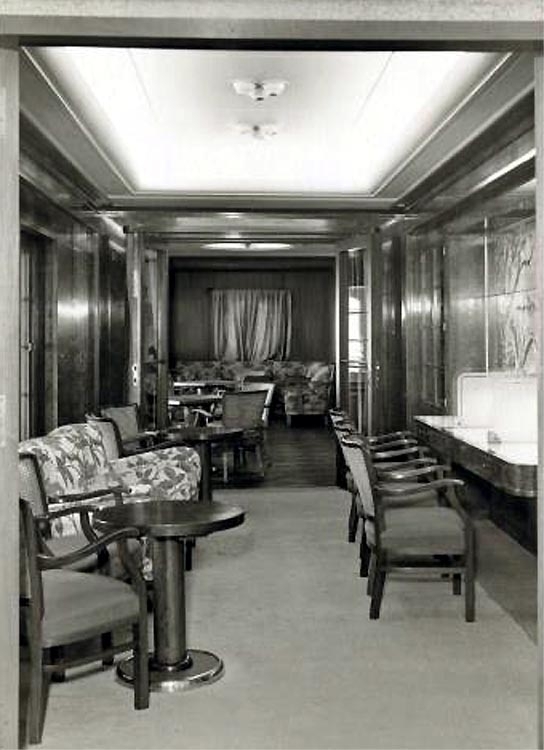
Above
& below: The Library,
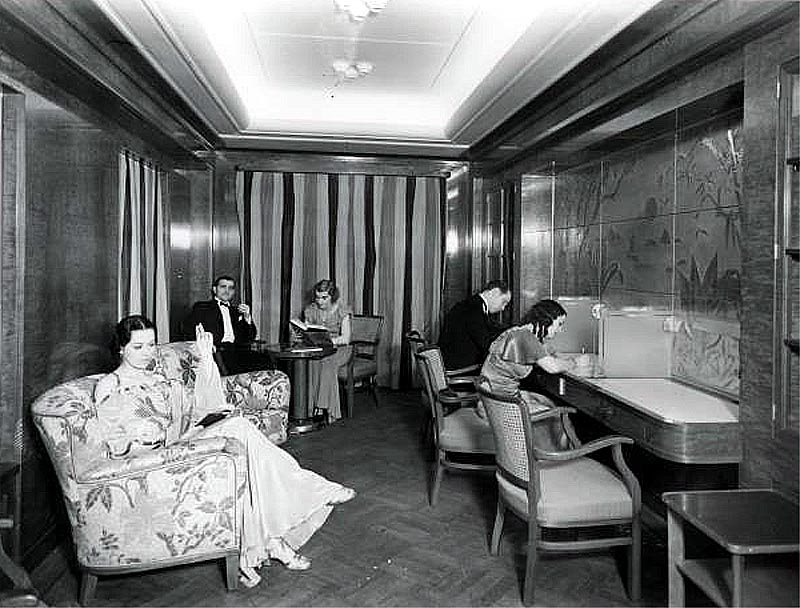
On the opposite (portside) of the Library, are the male and female facilities, and directly aft of both is the popular Smoking Room, with it bar and large murals.
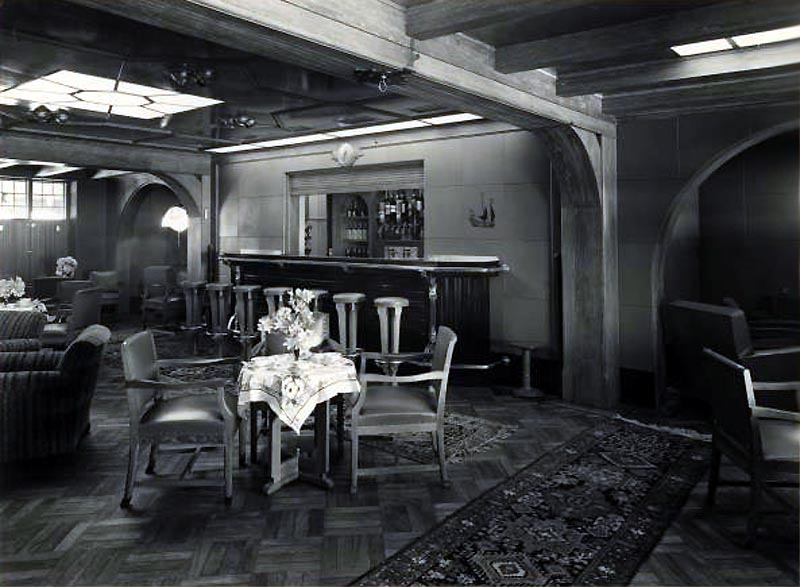
The
Smoking Room and bar looking aft to starboard
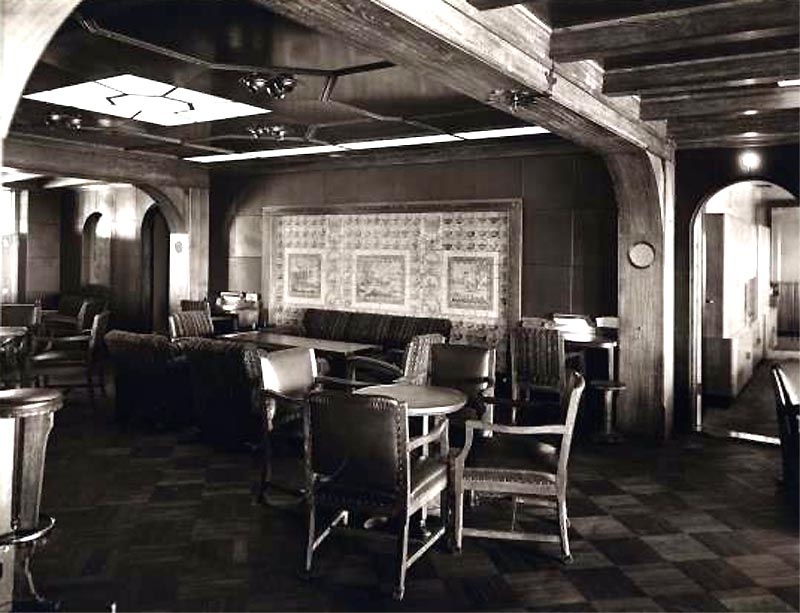
Another
photograph of the Smoking Room looking forward to port
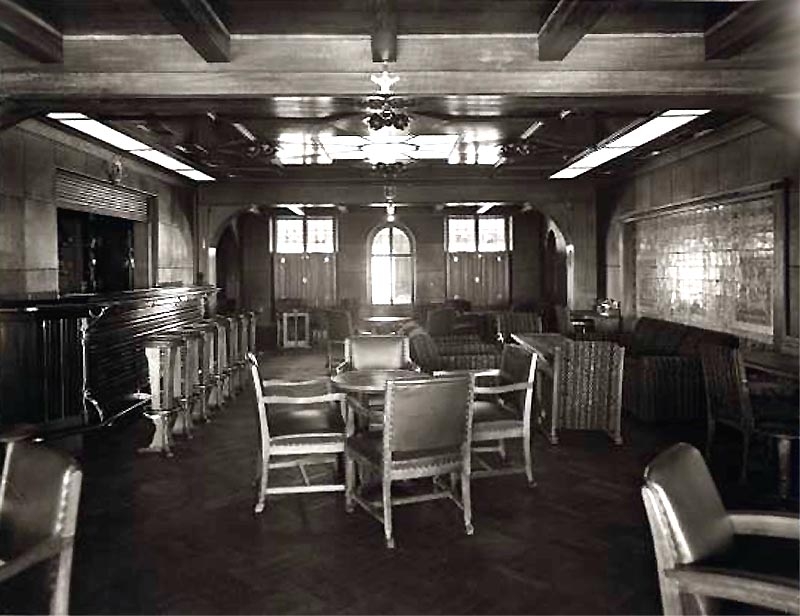
A view across the Smoking Room to port
Directly aft of the Smoking Room was a spacious Glass enclosed Recreation Deck, which was used for a variety of uses, including games, such as Horse Racing, Bowls, and other games, but also at night it was used as a Dance Venue.
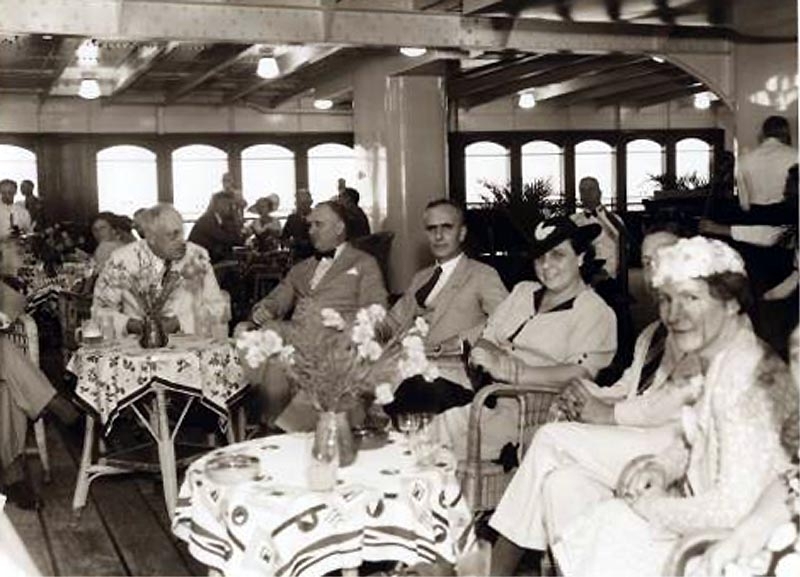
Here we see the Recreation Deck being used for a special festive occasions, whilst all dress up with the best daytime wear!
Directly aft of this was a U shape enclosure with glass sides, which was open towards the stern, containing the Pool Bar with ample tables and chairs, with the Swimming pool just aft as well as a spacious Sun Deck.
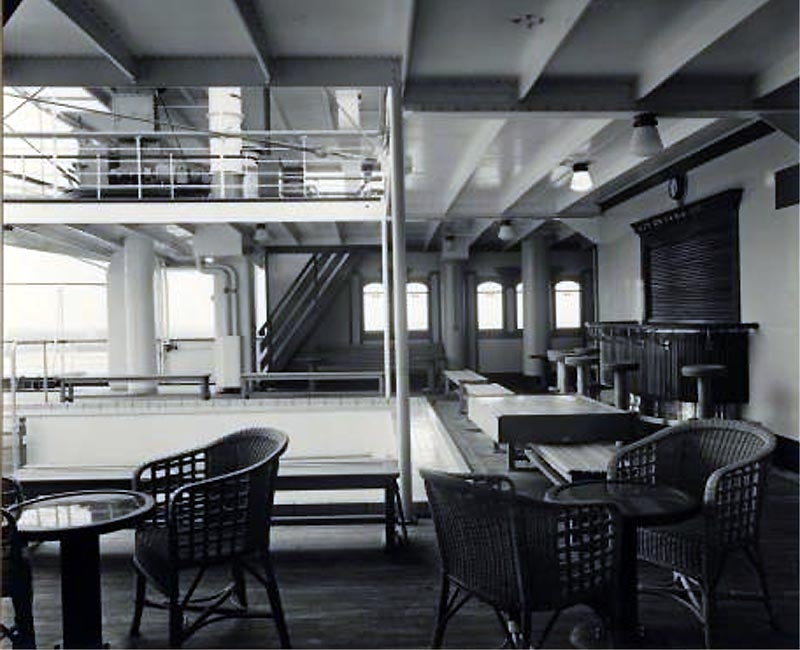
The Pool
bar with cane chairs and round glass topped tables
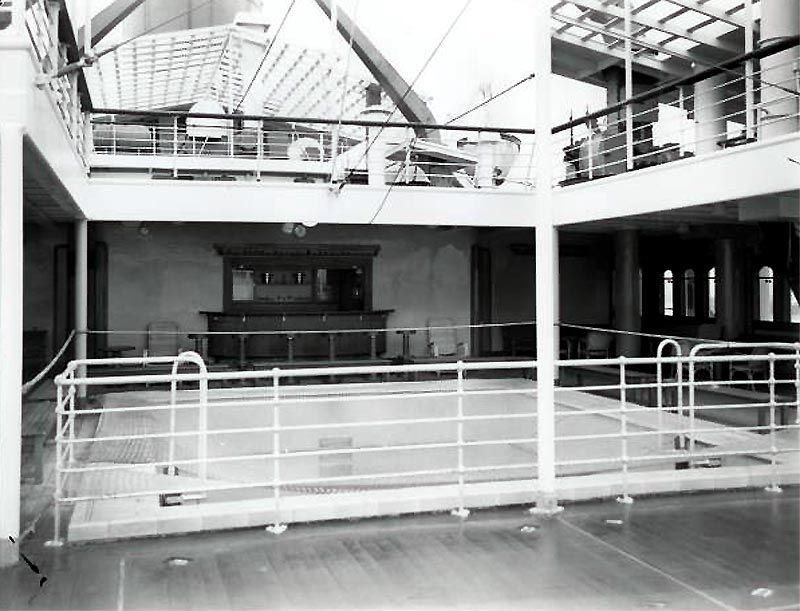
The Pool and its Bar, note that there was a hold covering just behind the pool that would be opened whilst in some ports
Of course Promenade deck was also a full walk around deck and more than half of this deck was fully glazed with spacious windows. The forward section near the Social Hall was used as a Verandah Café and was very popular during the day.
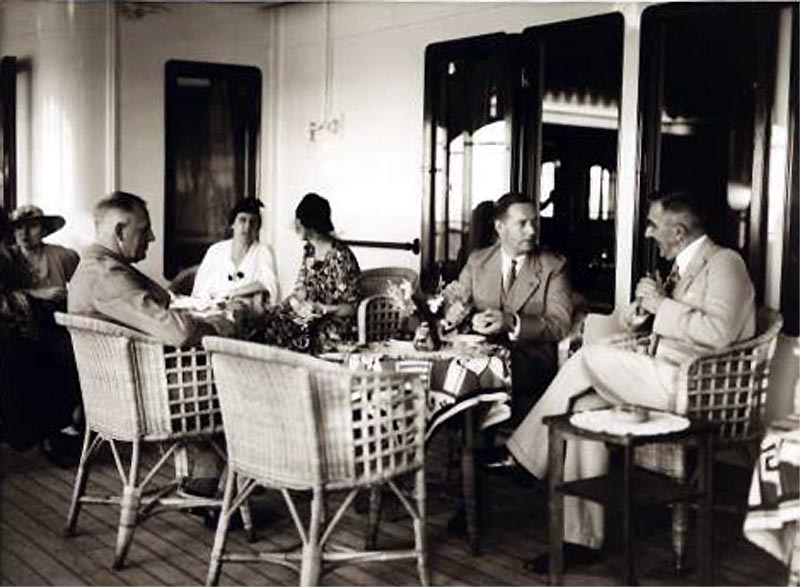
Passengers
seen on the port side Promenade Deck Veranda Café
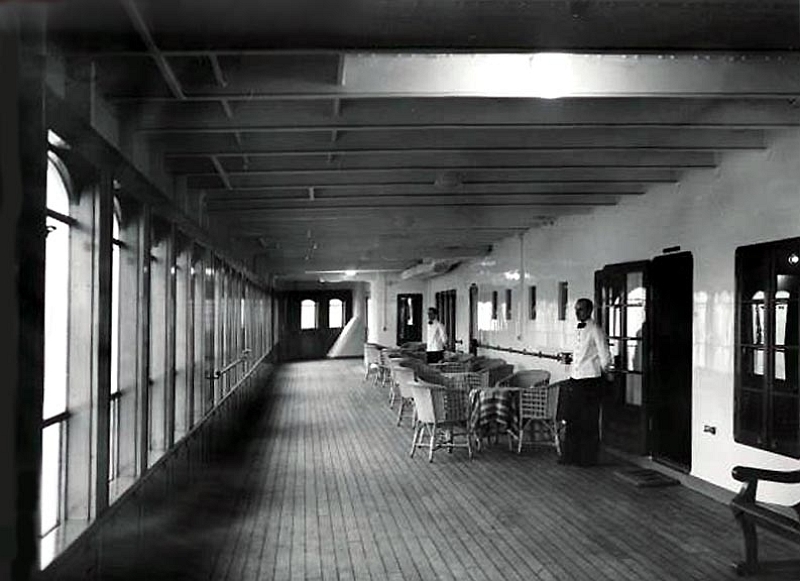
Above
& below: Here we see the port side forward
Promenade with the Veranda Café and some of the stewards
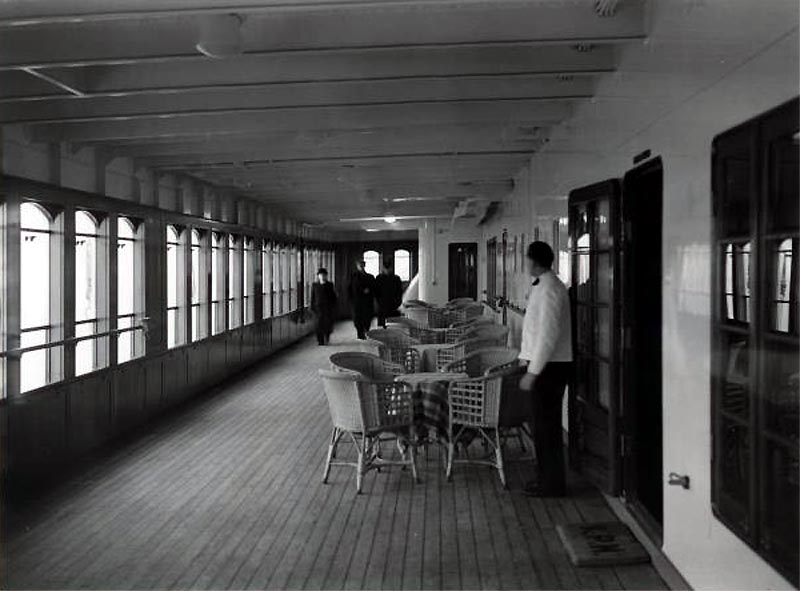
A Deck:
Forward of this deck were two Deluxe Suites, which were originally called ‘Cabin Deluxe.’ Each offered a separate bedroom and a spacious lounge, a large bathroom with a full bath with a shower over the bath and every possibly facility. Then there was also a spacious indoor verandah with two large windows for a fine ocean view.
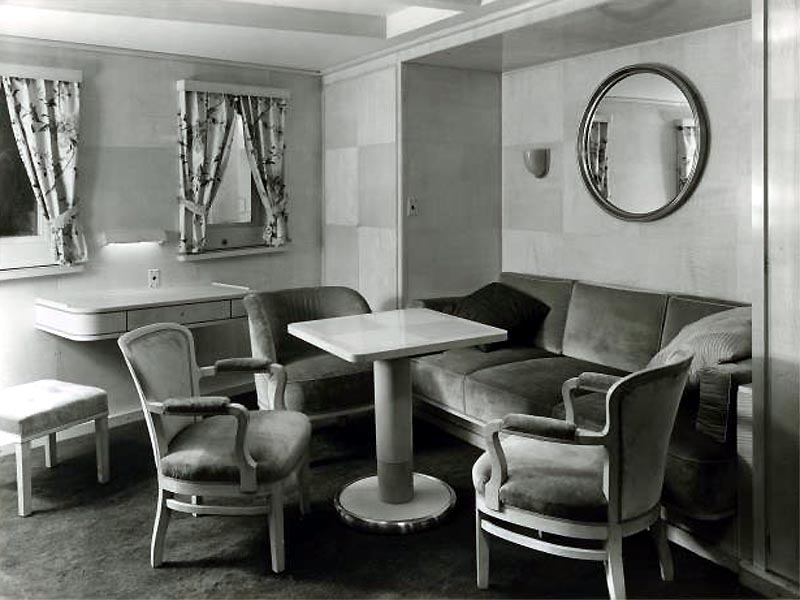
The
Portside Suite’s Lounge looking inboard to forward of the ship through
the windows
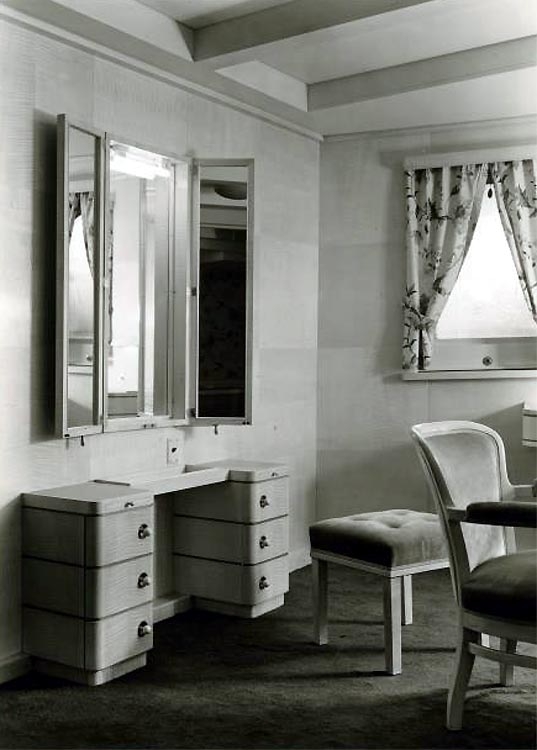
The same suite, but here we see a dressing table on the port side, with the forward windows showing.
The door
to the bathroom is directly to the left, but is out of sight
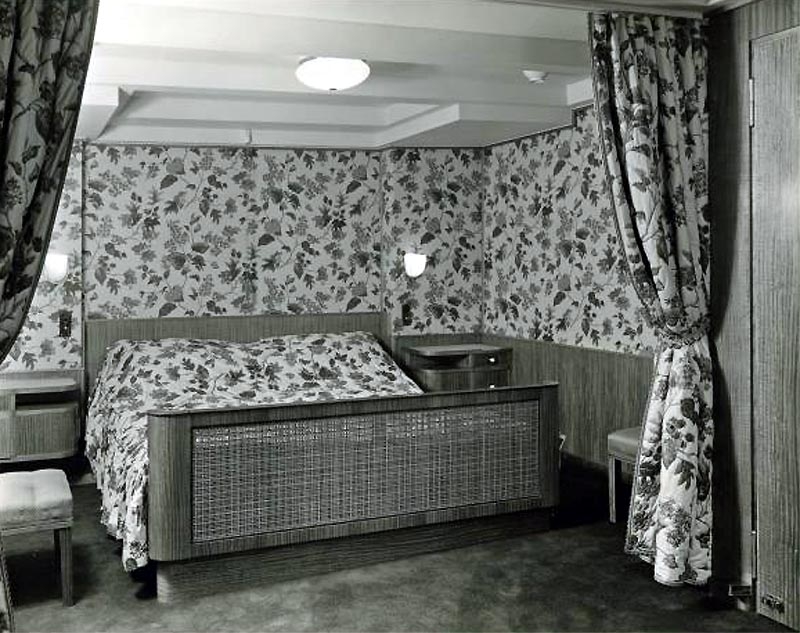
The floral inspired Suite bedroom
Amidships, just aft of the Deluxe Cabins was
the
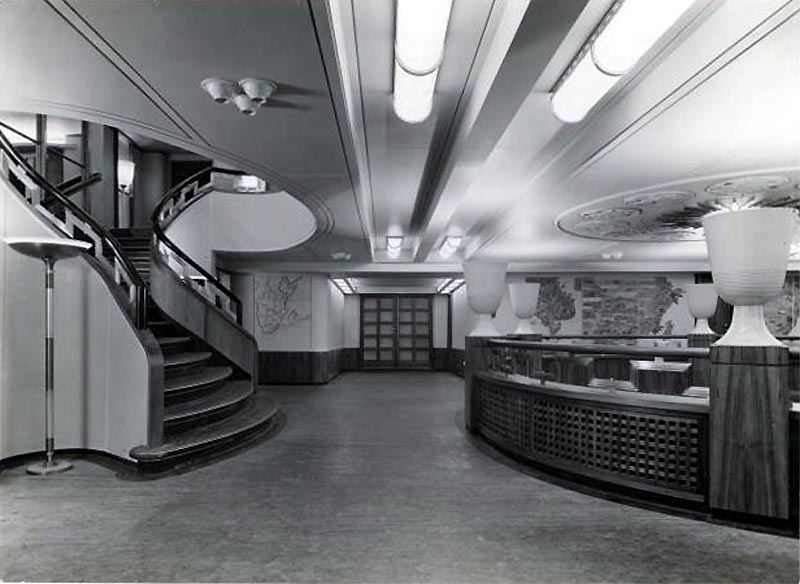
The Main
Entrance hall, with the stairwell up to Promenade Deck and the well over the
Dinning Room on the MS Boissevain
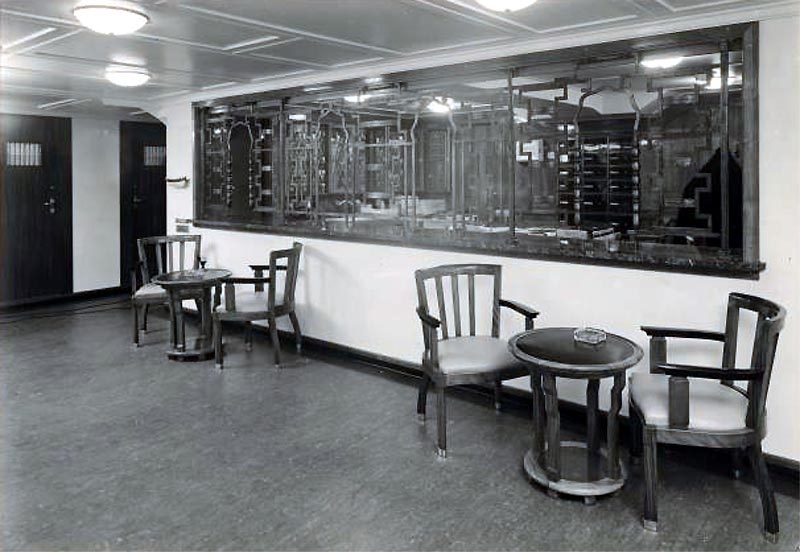
Pursers Office
The rest of the First Class section on this deck contained twin bedded cabins all having Private facilities.
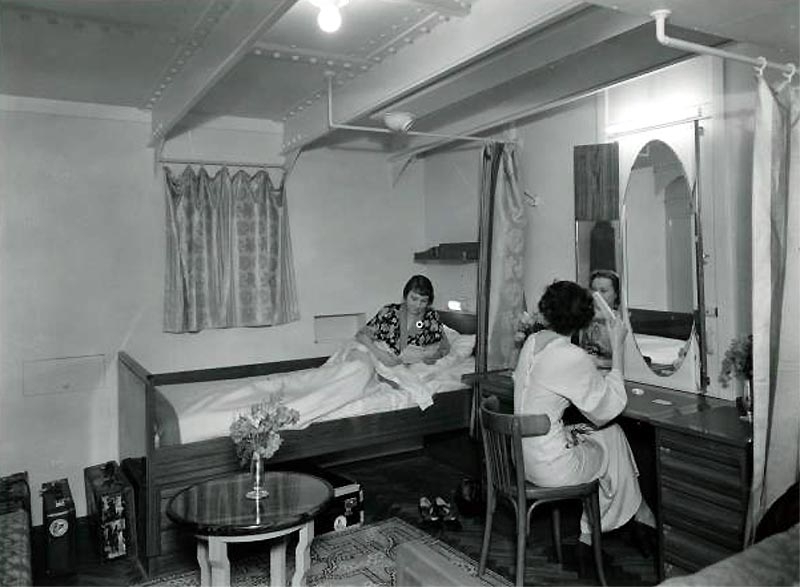
Twin bedded
Cabin A grade with facilities aboard the MS Boissevain
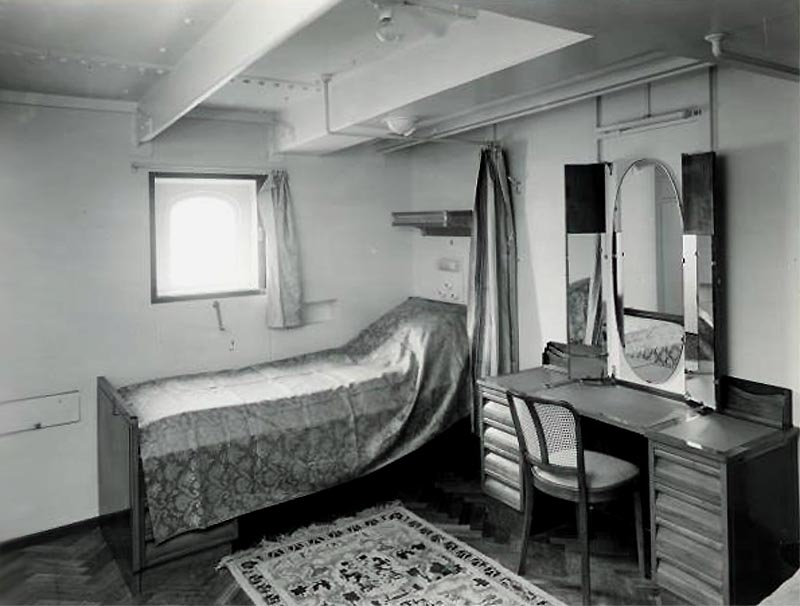
Twin Bedded Cabins B grade also with facilities
B Deck:
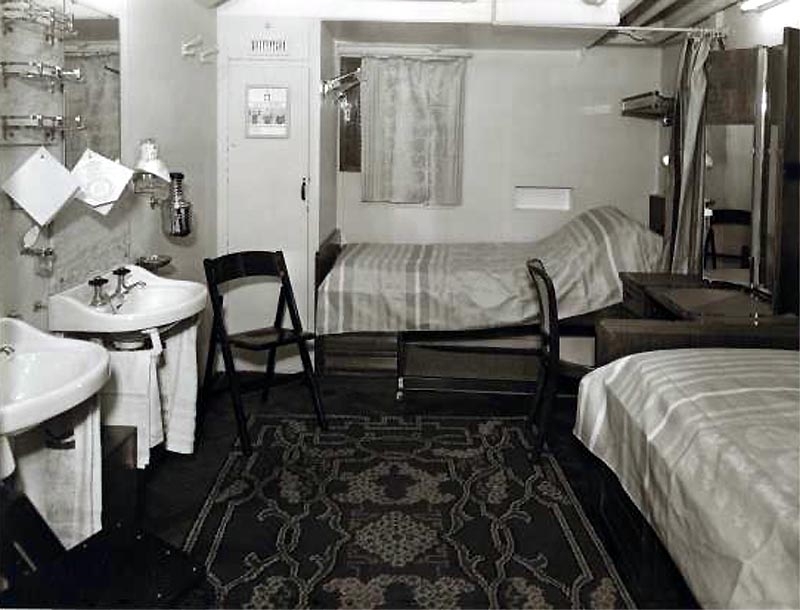
Here is one of the Twin Cabins without private facilities forward of the Dinning Room
Directly aft was these cabins was the spacious
Dinning Room, which was accessed by a stairs going down on two sides and then a
sweeping curved stairwell at the bottom of the Dinning Room offering quite a
dramatic entrance for dinners in the evening who would be dressed in their
finest!
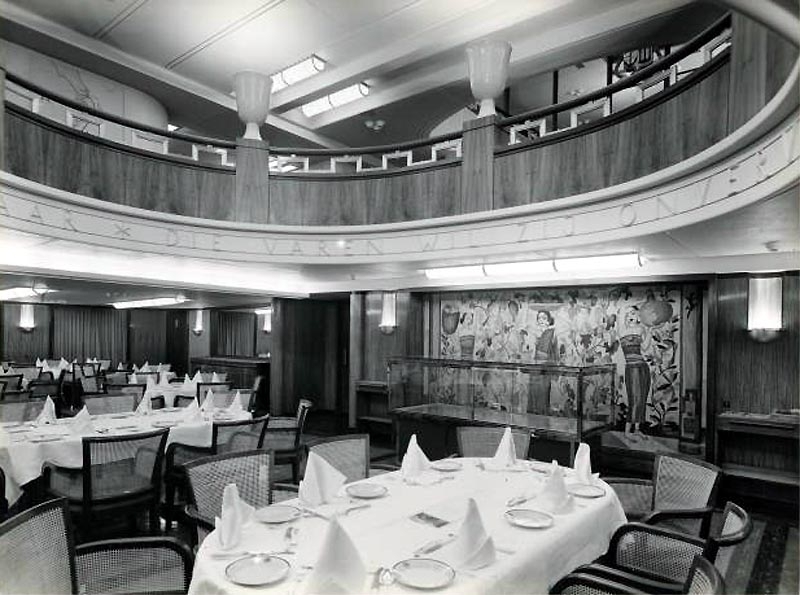
The
Dinning Room onboard the MS Boissevain
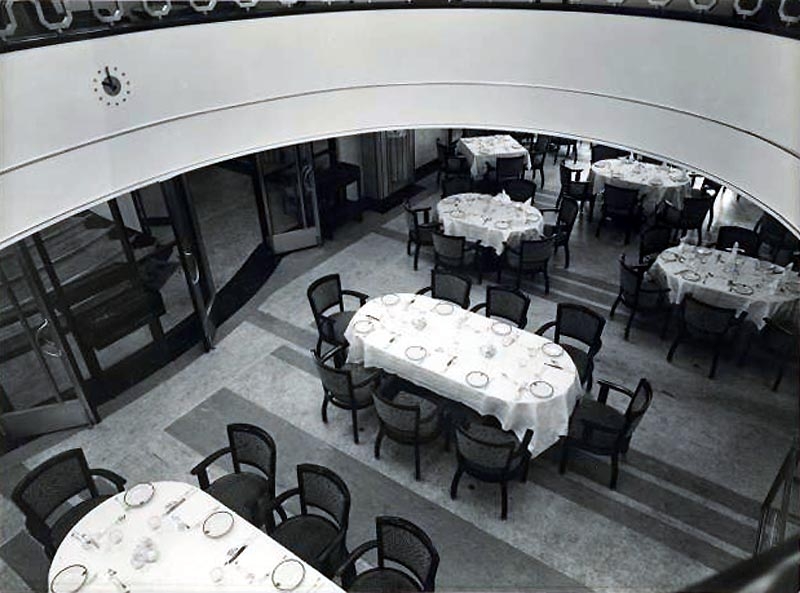
The
Dinning Room on the MS Tegelberg
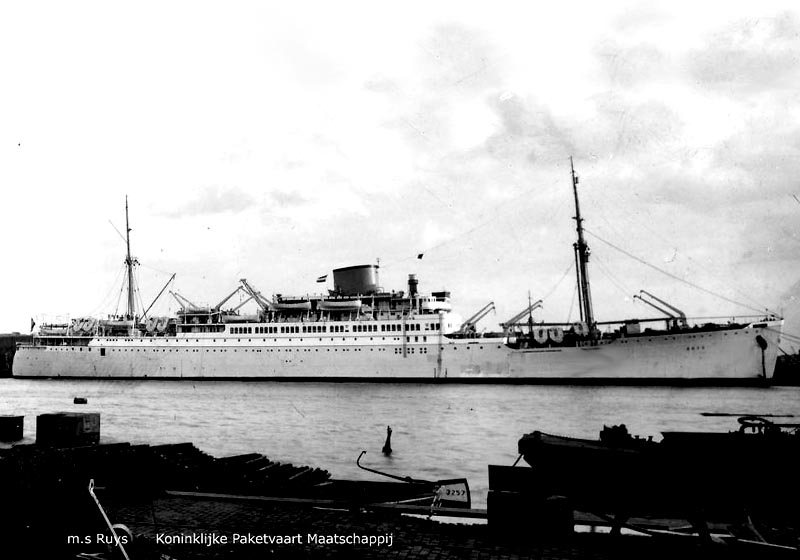
A MS Ruys postcard released by KPM
Holds, Cargo & Engines:
In her five cargo holds, each ship had space for the both bales, grain and other goods. Quantities are as follows;
MS Boissevain – (1), Ms Tegelberg = (2) & Ms Ruys = (3).
(1) Bales of goods 468000. cu.ft, (Cubic Feet) as well as 488000. cu.ft, of Grain, as well as some general cargoes and passenger belongings, etc. (2) Bales 471000. cu.ft, and Grain 491000. cu.ft, etc. (3) Bales 461000. cu.ft, and Grain 485000. cu.ft, etc.
Engines:
Before I continue with the construction, launching and completion of the MS Tegelberg and the Ruys, let me briefly cover these ships superb and most reliable and efficient diesel engines.
All three ships were powered by the following; Engine Type: 2-stroke single-acting diesel engines. Propulsion: Three 8-Cylinder Sulzer type, 25 9/16 x 47¼, each operating at 3,600 BHP, totalling at 10,800 HP. The engines operated three screws, which saw all three ships operate at a service speed of 16 knots. However they had a maximum speed of 18 knots, but had a reserve, which meant they could reach up to 20 knots, which was achieved when utilising all systems at top speed when required during WW2 in order to escape from a U-Boat
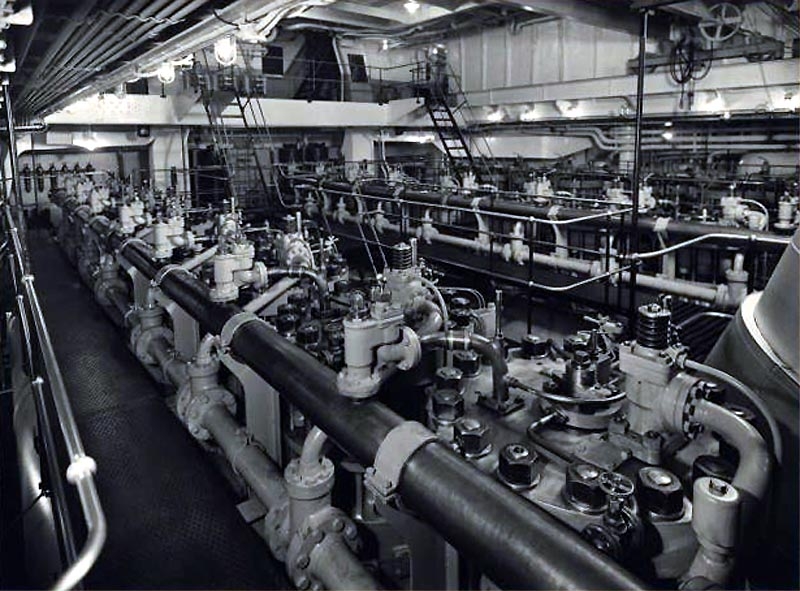
Above
& below: Enjoy the four photographs I have that
cover one of the Engine Rooms of The MS Boissevain
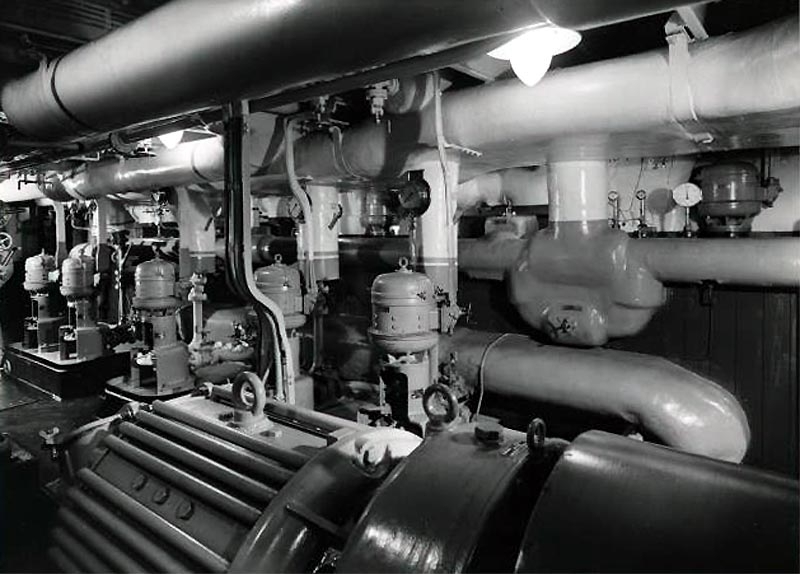
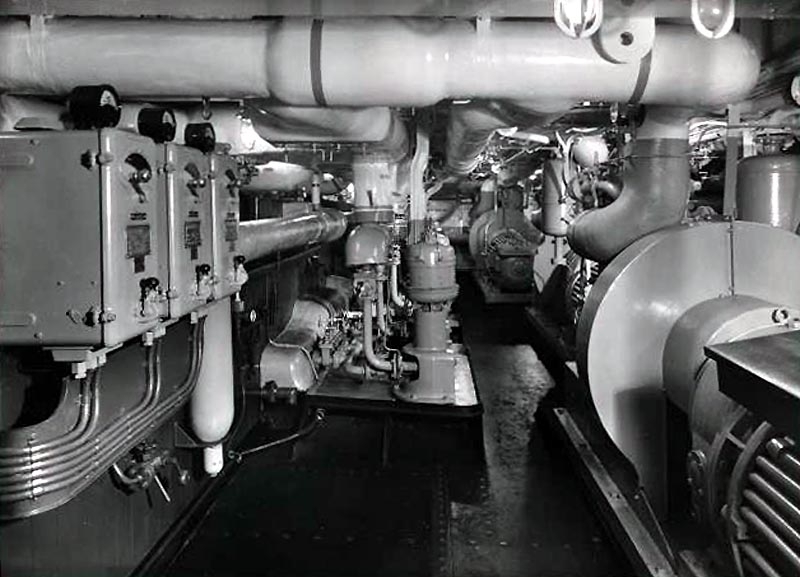
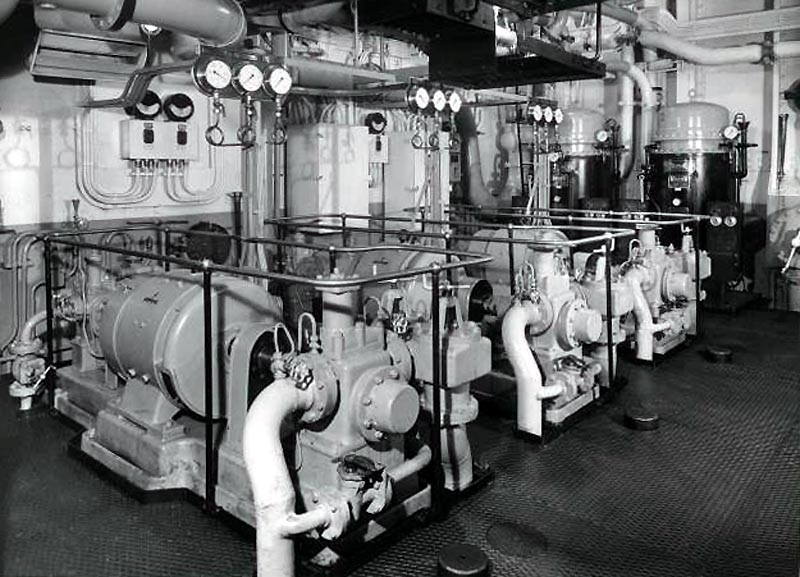
Neutral Netherlands
Despite the
Four days after the invasion on May 14, the
German Luftwaffe flew across
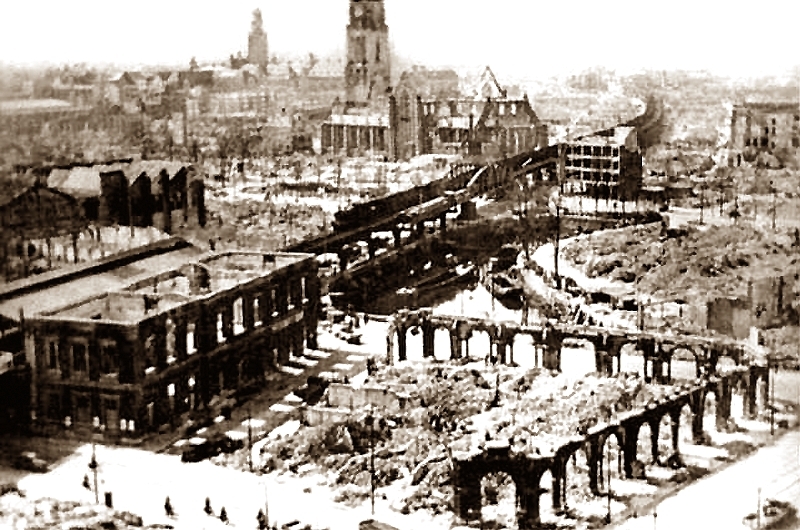
The city
of
Due to this catastrophe the
Final voyages prior to
becoming Troop Ships:
Finally, the MS Boissevain arrived from a voyage in Singapore on July 16, 1940 and due to the circumstances, with the Netherlands having been invaded, she would remain here for the next three weeks awaiting the Boissevain trio next phase;
MS Boissevain, like her sisters had been
chartered by the Netherland’s Government Ministry of War, which was in
exile in
MS Tegelberg: She had a similar experience as per the above, however sadly I do not have the particulars available as I do for the other two ships. But she had similar experiences.
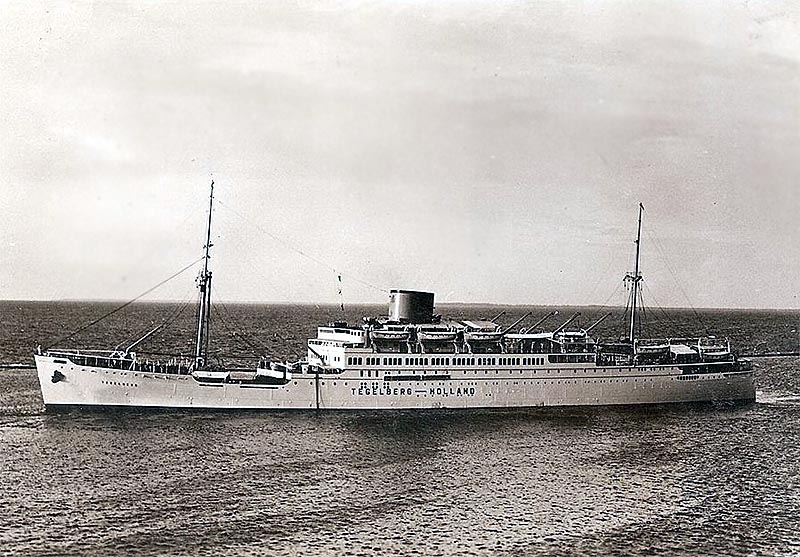
All three
ships were marked in 1938 showing that the
MS Ruys: On leaving Cape Town on July 23, 1940 the MS Ruys sailed directly
to Batavia, arriving on August 5, and departing on August 22, and she then
headed for Australian ports: sailing via Thursday Island arriving on Aug 31s,
then onto Brisbane where she arrived on September 3, and departed on September
5, the next port was Sydney arriving and departing September 7, the Melbourne
September 9, departing on September 11, then she headed for Adelaide where she
arrived on September 12. From
The
details of the ships war years will be covered on Part Two.
Built By:………………………………………………..(1)
.………………………………………………….…………(2) Netherland’s Shipbuilding Co,
……………………………………………………………..(3) De Schelde Shipyards,
Yard:……………………………………………………..(1) 510.
………………………………………………………………(2) 243.
………………………………………………………………(3) 204.
Launched:……………………………………………..(1) June 3, 1937.
……………………………………………………………..(2) July 10, 1937.
……………………………………………………………..(3) September 25, 1937.
Call signs:…………………………………………….(1) PKQA 1938/47 - PDEP 1947-68
……………………………………………………………..(2) PKOI 1938/47 - PHWZ 1947-68.
……………………………………………………………..(3) PKOJ 1938/47 - unknown 1947-68.
Homeport/Flag:
…………………………………….Amsterdam, the
………………………………………………………………
Tonnage:…………………………….…………………(1) 14,134 GRT.
………………………………………………………………(2) 14,150 GRT.
………………………………………………………………(3) 14,155 GRT.
Length:………………………………………………….170.5m - 559ft.
Breadth:…………………………………………………22.0m - 72.2ft.
Draught:……………………………………………….9.19m - 30.2ft.
Propulsion:……………………………………………three De Schelde Sulzer diesel engines, 3,600 BHP each,
………………………………………………………………totalling 10,800 HP. Built by the ship builders.
Propellers:…………………………………………….Tripe screws.
Speed: …………………………………………………..16 knots service speed, 20 knots maximum.
Passengers:……………………………………………As built; 82 First, 72 Second & 500 Third Class.
Refitted in:…………………………………………….(1 & 3) in 1961, (2) in 1962 ….
Passengers:……………………………………………131
First, 84 Second & 179 Third Class.
KPM & RIL INDEX:
Part One … MS Boissevain, MS Tegelberg &
MS Ruys; 1937/38 to 1942.
Part Two … Their trooping years
Part Three … Deck Plan, Brochures & Schedules, and Memorabilia.
MS Tjiwangi & Tjiluwah …
MS Straat Banka … A luxurious
KPM/RIL 50 passenger-cargo liner, and her 2 sisters.
************************
I watched them come, I watched them go, and I watched them die.”
************************
ENTER OUR ssMaritime MAIN INDEX
This notice covers all pages, although, and I have done my best to ensure that all photographs
are duly credited and that this notice is displaced on each page, that is, when
a page is updated!
